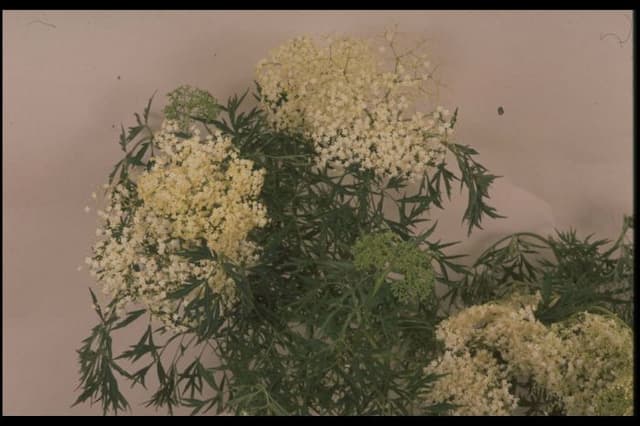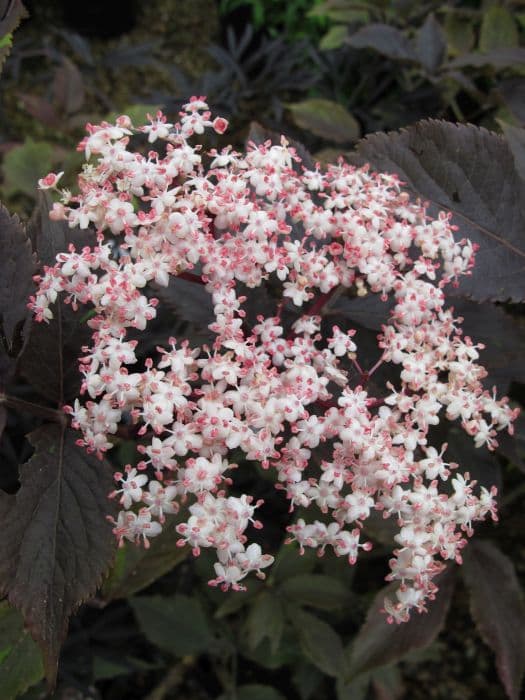Japanese Snowball Viburnum plicatum f. tomentosum 'Summer Snowflake'

ABOUT
'Summer Snowflake' is an ornamental shrub known for its distinctive layered, horizontal branching that gives it an elegant, tiered appearance. This shrub features a multitude of flat-topped flower clusters, each one resembling a delicate lacecap, which bloom profusely in the late spring and sporadically throughout the summer. The flowers are predominantly white, with each small floret creating a frothy, snow-like effect, hence the name 'Summer Snowflake.' In autumn, the flowers give way to small, red berry-like fruits that mature to black, adding seasonal interest. The leaves of this shrub are dark green, oval-shaped with pointed tips and deeply veined, creating a pleated or crinkled texture, as referenced in the word 'plicatum' in its name. Come fall, the foliage can turn to a beautiful reddish-purple, providing a striking contrast to the plant's earlier floral display. While it is not to discuss the size, 'Summer Snowflake' has a bushy, rounded growth habit that contributes to its use in landscaping as an attractive specimen. Its general shape and texture, combined with its showy flowers and colorful berries, make 'Summer Snowflake' a popular choice for gardens where seasonal visual interest is desired.
About this plant
 Names
NamesFamily
Adoxaceae.
Synonyms
Japanese Snowball, Doublefile Viburnum, Summer Snowflake Viburnum.
Common names
Viburnum plicatum f. tomentosum 'Summer Snowflake'.
 Toxicity
ToxicityTo humans
The common name for Viburnum plicatum f. tomentosum 'Summer Snowflake' is Doublefile Viburnum. This plant is generally not considered toxic to humans. There are no well-documented cases of poisoning from ingesting Doublefile Viburnum. Therefore, it's not known to pose significant health risks if consumed in small quantities. However, as with any plant, individual sensitivities can vary, and consumption of large amounts could potentially cause stomach upset or other gastrointestinal discomfort due to the fibrous plant material.
To pets
Doublefile Viburnum is not commonly known to be toxic to pets either. It is unlikely to cause serious harm if ingested by pets such as dogs or cats. However, like in humans, individual animals might experience mild stomach discomfort if they consume parts of the Doublefile Viburnum due to the non-digestible nature of the plant material. Serious poisoning symptoms are not typically associated with this plant. Always monitor pets around plants and consult a veterinarian if any unusual symptoms arise after ingestion.
 Characteristics
CharacteristicsLife cycle
Perennials
Foliage type
Deciduous
Color of leaves
Green
Flower color
White
Height
6 feet (1.8 meters)
Spread
6 feet (1.8 meters)
Plant type
Shrub
Hardiness zones
5
Native area
Asia
Benefits
 General Benefits
General Benefits- Ornamental Value: 'Summer Snowflake' offers multi-season visual interest with its layered branches, white lacecap flowers in spring, and red to black fruit in fall.
- Landscape Versatility: This shrub can fit into various landscape designs, including formal gardens, foundation plantings, and mixed borders.
- Easy to Grow: It is known to be relatively easy to grow, with no specific soil pH requirements and the ability to thrive in a range of soil types.
- Wildlife Attraction: Berries produced in the fall can attract birds, providing a food source and encouraging biodiversity in the garden.
- Low Maintenance: Once established, it has low water requirements and generally requires little pruning other than to maintain its shape or remove any dead or diseased wood.
- Shade Tolerance: Can tolerate partial shade, making it versatile for spots in the garden that don't receive full sunlight.
- Seasonal Interest: Offers interest from early spring with its flowers, through summer with its foliage, and into fall with berries and sometimes reddish fall foliage.
 Medical Properties
Medical Properties- This plant is not used for medical purposes.
 Air-purifying Qualities
Air-purifying QualitiesThis plant is not specifically known for air purifying qualities.
 Other Uses
Other Uses- Summer Snowflake hedge or privacy screen: Its dense foliage and growing habit make it suitable for creating a natural screen or hedge around your property.
- Backdrop in floral arrangements: The flowers and foliage of Summer Snowflake can provide a lush, textured background in floral displays and decorations.
- Nectar source for beekeeping: The flowers produce nectar that is attractive to bees, making them a beneficial addition to gardens for beekeepers.
- Host plant for butterfly larvae: Some species of butterflies use Summer Snowflake as a larval host plant, contributing to butterfly populations.
- Garden sculpture: With careful pruning, Summer Snowflake can be shaped into various forms, making it a living piece of garden art.
- Urban landscaping: Due to its tolerance of pollution, it is often used in urban areas for roadside planting or in parks for its ornamental value.
- Rain garden plant: This shrub is suitable for rain gardens as it can cope with an occasional excess of water while helping to filter runoff.
- Winter interest: The red berries and textured branches of Summer Snowflake provide visual interest in the garden during the winter months when little else is blooming.
- Cultural symbolism: In some cultures, the plant may be used in festivals or ceremonies for its symbolic meanings, such as purity or renewal.
- Wildlife shelter: The dense growth of Summer Snowflake can provide shelter and nesting opportunities for birds and other small fauna.
Interesting Facts
 Feng Shui
Feng ShuiThe Japanese Snowball is not used in Feng Shui practice.
 Zodiac Sign Compitability
Zodiac Sign CompitabilityThe Japanese Snowball is not used in astrology practice.
 Plant Symbolism
Plant Symbolism- Renewal: The 'Summer Snowflake' variety of Viburnum blooms in intervals throughout the summer months, symbolizing the continual process of renewal and rejuvenation.
- Inner Growth: With its lush, layered foliage, the plant represents the complexity of inner growth and the beauty of personal development.
- Purity: The white flowers of the Summer Snowflake Viburnum are often associated with purity and innocence, reflecting the plant's snow-like appearance even during the warmest seasons.
- Abundance: This shrub is known for its generous display of flowers, symbolizing abundance and the generosity of nature.
- Perseverance: As a hardy plant that can thrive in a variety of conditions, the Summer Snowflake represents the ability to endure challenges and persevere through hard times.
 Water
WaterThe Japanese Snowball 'Summer Snowflake' should be watered deeply once a week, providing about 1 to 1.5 inches of water each time. During hot or dry spells, increase the frequency to twice a week. The soil should be moist but not soggy, and it is essential to water the plant at the base to avoid wetting the foliage. In winter, reduce watering since the plant requires less moisture. For container-grown specimens, ensure they are watered thoroughly until excess water drains out of the bottom.
 Light
LightThe Japanese Snowball 'Summer Snowflake' prefers full sun to partial shade. It thrives best when planted in a location that receives morning sunlight and partial shade in the afternoon to protect it from the intense heat. The ideal spot is one where it can get at least 4 to 6 hours of direct sunlight per day.
 Temperature
TemperatureThe Japanese Snowball 'Summer Snowflake' can endure temperatures as low as 15 degrees Fahrenheit and as high as 90 degrees Fahrenheit. However, the ideal range for promoting vigorous growth and flowering is between 60 to 75 degrees Fahrenheit. Protection from extreme temperatures is beneficial, especially from harsh winter winds and the intense afternoon heat in summer.
 Pruning
PruningPruning the Japanese Snowball 'Summer Snowflake' is mainly done for shaping and removing dead or diseased branches. The best time to prune is late winter or early spring before new growth begins. Pruning can be done annually, but it is not strictly necessary every year unless the shrub has outgrown its space or needs aesthetic shaping.
 Cleaning
CleaningAs needed
 Soil
SoilThe Japanese Snowball 'Summer Snowflake' prefers a well-draining, fertile soil with a pH between 5.6 and 6.6. The best soil mix can be made by combining loamy garden soil with peat, compost, and a small amount of perlite or sand to improve drainage.
 Repotting
RepottingMature Japanese Snowball 'Summer Snowflake' shrubs do not require frequent repotting as they are typically grown in the ground. Younger plants or those grown in containers should be evaluated annually for repotting but typically need it every 2-3 years.
 Humidity & Misting
Humidity & MistingJapanese Snowball 'Summer Snowflake' does well in average outdoor humidity levels. While it doesn't require high humidity, it's tolerant of a range of conditions typical of temperate climates.
 Suitable locations
Suitable locationsIndoor
Grow in bright, indirect light and water moderately.
Outdoor
Plant in well-draining soil, full sun to partial shade.
Hardiness zone
5-8 USDA
 Life cycle
Life cycleViburnum plicatum f. tomentosum 'Summer Snowflake', commonly known as the Doublefile Viburnum, begins its life cycle as a seed that germinates in moist, well-draining soil, typically in the spring. The seedling emerges and develops into a young plant, exhibiting rapid vegetative growth and developing characteristic serrated leaves. As the plant matures, usually within a few years, it enters the blooming stage each spring, displaying an array of white, lace-cap flowers that are attractive to pollinators like bees and butterflies. Following pollination, the flowers develop into small red berries that gradually turn black, providing food for birds and allowing for seed dispersal. The plant reaches full maturity in several years, developing a robust, multi-stemmed shrub form with layered branches. The Doublefile Viburnum has a perennial life cycle, repeating its growth, flowering, and fruiting stages annually for many years, often several decades, before eventually declining in vigor and productivity as it reaches the end of its life span.
 Propogation
PropogationPropogation time
Spring-Early Summer
Propogation: The most popular method of propagating the 'Summer Snowflake,' also known as the doublefile viburnum, is through softwood cuttings. This is typically done in late spring or early summer, when new growth is mature enough to be firm but still young. A cutting should be about 4 to 6 inches (approximately 10 to 15 centimeters) in length and include several sets of leaves. The bottom leaves are removed, and the cut end of the cutting is dipped in rooting hormone before being planted in a well-draining soil mix. The cuttings should be kept moist and in indirect sunlight until roots develop, which generally takes a few weeks. Once the rooting has occurred, the new plants can be transferred to individual pots to grow on before being planted out into the garden.









